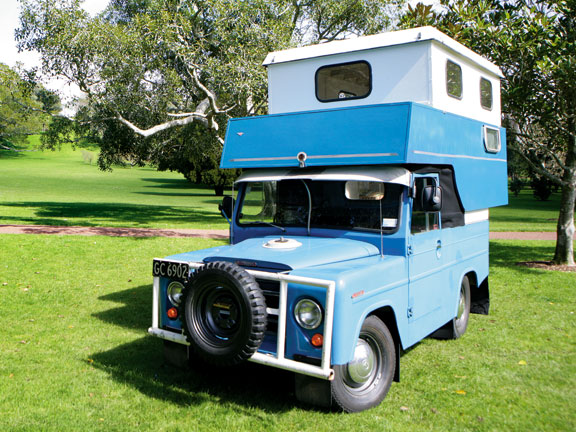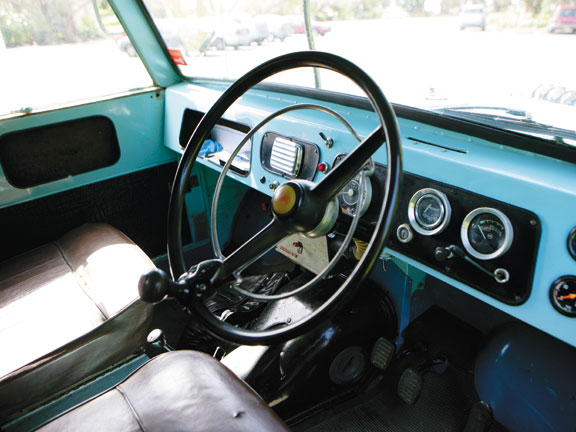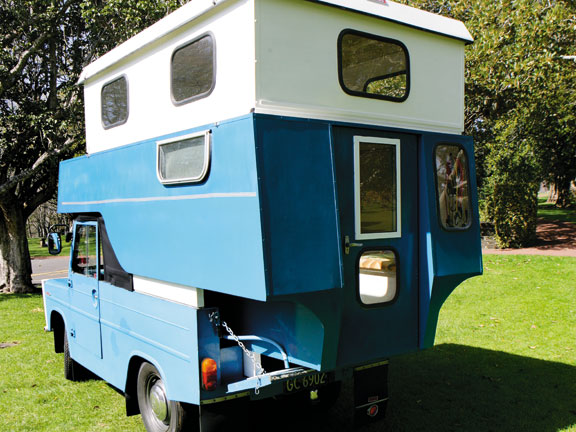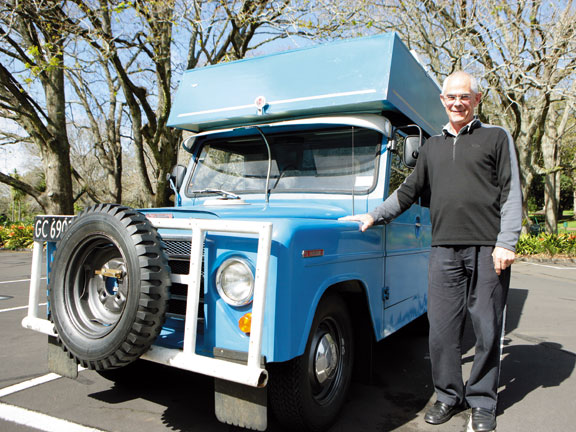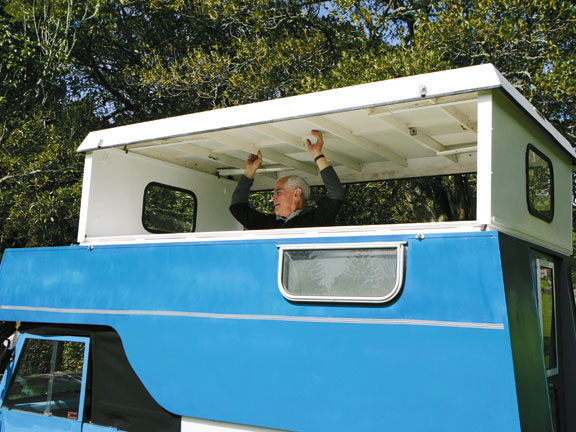But for a failed meat delivery, it is unlikely the Trekka – the only vehicle to be designed and mass-produced in New Zealand – would have seen the light of day. In fact, Trekka's time in the limelight was brief. Between 1966 and 1973, just 2500 were built and only a handful remain roadworthy.
Auckland car collector Bob MacIntyre has one of them – a fully-restored vibrant blue beauty, with fine gold trim. It is a work of art. And that's just the outside. The interior accommodation is bright white, offset with traditional lino and upholstery.
Lift the bonnet (noting the quaint hinges as you do) and you'll find one of the tidiest – and perhaps one of the tiniest – car engines you're likely to see. Not a lick of oil or an unruly wire in sight.
Bob defers the praise for this unusually clean engine to his son, Spencer, who is an automotive electrical engineer. Spencer's skill is similarly evident, as the Trekka fires to life on the first turn and we're away, not exactly silently, slipping through Auckland traffic for a photo session at Cornwall Park, where Bob lifts the lid on the cleverly-contrived accommodation.
It may not be at the contemporary push of a button, but some very thoughtful design has gone into the creation of a functional living space, with generous headroom and a slide-out double bed which locks into position with a satisfying click.
Externally, the Trekka's boxy appearance is in contrast to the sleek, aerodynamic exteriors of a modern-day RV, yet it compares favourably with its comtemporaries that it was designed to emulate: Land Rovers.
And the price was right. In the highly-regulated market of the 60s, it was difficult and expensive to purchase a new car – imports were restricted and tariffs high. To sidestep heavy tax duties, the Trekka was sourced and sold as an agricultural vehicle. Because it was made from cheap Czechoslovakian parts and manufactured in New Zealand, it was able to undercut most other cars on the market and initially sold well.
The majority of purchasers were trades-people or farmers. However, the vehicle quickly hit strife in the farm sector when it failed to live up to expectations. At fault was the two-wheel drive capacity which did not stand up to the manufacturer's claims that it would perform like a Land Rover.
Kiwi ingenuity was quickly deployed by the manufacturers and an ingenious balanced traction differential, designed by Papatoetoe engineer Ray Stone, was installed as an optional extra for the princely sum of $20.
Kiwi ingenuity and Skoda parts from Czechoslovakia seem like unlikely bed partners and the story of their marriage is as intriguing as the vehicle that became the sum of them.
Flash back to the early 60s and the (then) New Zealand Meat Board despatched a shipment of prime cuts to Czechoslovakia, only to have the cheque bounce. A second despatch followed – this time of meat board representatives keen to elicit some form of payment from the bankrupt Czechoslovakians.
The only thing of value proffered was a warehouse of Skoda Octavia parts which the kiwis deemed of little value, but better than nothing. They were both right and wrong. The parts languished for some time in a Napier warehouse before Phil Andrews, the owner of Palmerston North company Motor Lines, offered to buy them piecemeal.
Phil was keen to build a New Zealand motor vehicle and his prototypes attracted the interest of independent car assembler Noel Turner. A joint venture was initially mooted. However, the details of the subsequent deal, which saw Noel form his own company, Motor Holdings, are mired and murky.
Noel's Otahuhu plant churned out thousands of Trekkas between 1968 and 1973. Many were shipped to Australia; others to Vietnam. Yet the car that is as kiwi as Hokey Pokey ice cream, jandals and the Buzzy Bee is as rare today as rocking horse droppings. This is exactly why Bob Macintyre had to have one (or two or three).
Bob is the owner of Lloyds Shipping, an Auckland-based company which specialises in the international shipping of 'ugly freight' – freight like boats and motorhomes which don't fit in your average container. How he became a shipping merchant is another story entirely, but essentially, Bob was a lawyer-turned-car-importer who entered the shipping industry accidentally by virtue of his car imports.
He is a passionate collector of classic cars, the majority of them timeless and elegant – neither of which are adjectives that could be employed to describe the Trekka. And yet the Trekka he built and restored from two donor cars is the vehicle Bob is most likely to use and drive with pride.
Bob began his online search in 2010 and bided his time until the right vehicle came along. Trekkas are notoriously prone to rust. However, Bob was able to eventually find a Trekka which had been kept under cover and rebuilt it from two lesser vehicles.
With Spencer's help, he has restored the vehicle to as-new condition, marrying the ute body with an original Trekka camper canopy, which was bought separately in Northland. Again, luck was on his side. The canopy – which like all Trekka campers had been manufactured by Sprite Caravans to become what was arguably the country's first camper – had also been kept under cover.
Bob's bright blue Trekka can frequently be seen around Auckland and wherever he goes, it attracts numerous fans and admirers.
“I never cease to be amazed by how many people come up and talk to me. It seems there are Trekka enthusiasts everywhere,” he says.
Add my name to that list.
Feel free to make a comment or ask us a question about this story on the MCD  page.
For the latest reviews, subscribe to our Motorhomes, Caravans & Destinations magazine here.
page.
For the latest reviews, subscribe to our Motorhomes, Caravans & Destinations magazine here.
 page.
For the latest reviews, subscribe to our Motorhomes, Caravans & Destinations magazine here.
page.
For the latest reviews, subscribe to our Motorhomes, Caravans & Destinations magazine here. 
